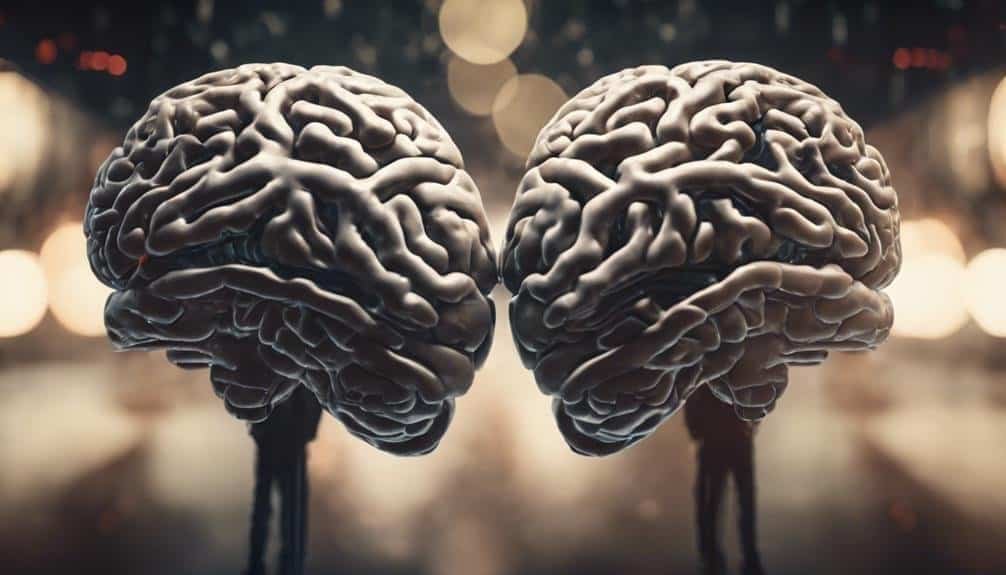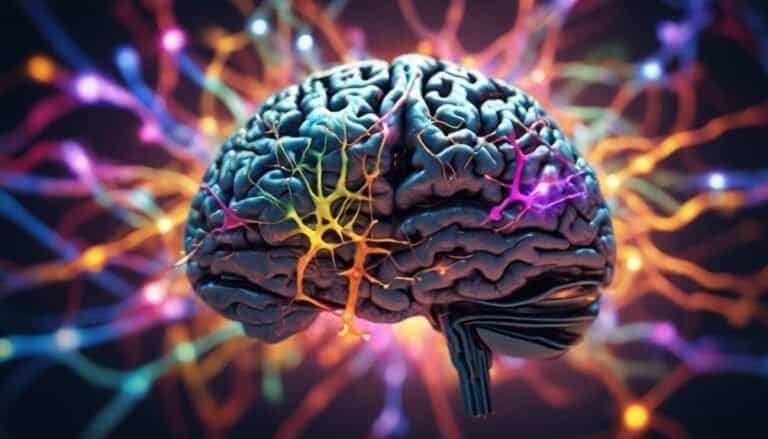Brain Strategies for Conflict Resolution
As you navigate the complex landscape of conflict, your brain can be a powerful ally. Imagine having a toolbox of strategies designed to help you defuse disputes and foster understanding.
By exploring the intricate workings of your mind, you can uncover effective approaches to resolve conflicts with grace and tact. But how exactly do these brain strategies work, and what can they offer in your quest for harmonious relationships?
Key Takeaways
- Amygdala assesses threat levels while prefrontal cortex aids rational analysis.
- Emotion regulation techniques like deep breathing and positive self-talk enhance conflict resolution.
- Cognitive flexibility practices and adaptive thinking strategies empower creative conflict solutions.
- Active listening strategies, including reflective listening and attention to nonverbal cues, foster understanding and resolution.
Understanding Brain Responses
To understand how your brain responds during conflict, it's essential to delve into the intricate neural processes that shape your reactions and decision-making. When faced with conflict, your brain undergoes a series of responses aimed at resolving the situation. Conflict resolution is a complex interplay of various brain regions working together to assess threats, regulate emotions, and make decisions.
The amygdala, known for its role in processing emotions, plays a crucial part in evaluating the perceived threat level of the conflict. Simultaneously, the prefrontal cortex, responsible for higher-order thinking, helps in analyzing the situation rationally and considering various solutions.
As you navigate through conflicts, your brain responses are crucial in determining the outcome. Understanding how these neural processes influence your behavior can empower you to approach conflicts more effectively. By recognizing the interplay between brain responses and conflict resolution, you can develop strategies to manage conflicts constructively and foster better relationships.
Emotion Regulation Techniques
Let's explore two effective techniques for regulating your emotions during conflicts:
- Deep breathing exercises can help calm your mind and body when tensions rise. Taking slow, deep breaths allows you to approach the situation with clarity and composure.
- Positive self-talk can shift your mindset towards a more optimistic and constructive outlook. This can aid in resolving conflicts more effectively.
Deep Breathing Exercises
Engage in deep breathing exercises regularly to help regulate your emotions effectively. Mindful breathing can be a powerful tool in managing conflict.
When you feel overwhelmed or stressed, take a moment to focus on your breath. Inhale slowly and deeply, feeling your lungs expand, then exhale, releasing tension and worries.
These relaxation techniques can calm your mind and body, allowing you to approach conflicts with a clearer perspective. By incorporating deep breathing into your daily routine, you equip yourself with a valuable skill to navigate challenging situations more calmly and rationally.
Positive Self-Talk
Incorporate positive self-talk into your daily routine to enhance your ability to regulate emotions effectively during conflicts. Inner dialogue is a powerful tool that can help you navigate challenging situations with a clear and calm mind.
When faced with conflict, practice encouraging mantras such as 'I can handle this' or 'I choose peace' to reinforce a positive mindset. By consciously engaging in positive self-talk, you can shift your perspective and approach conflicts with a more constructive attitude.
Cognitive Flexibility Practices
You know that resolving conflicts requires a nimble mindset.
By practicing mindful problem-solving techniques, you can navigate challenging situations with more ease.
Adaptive thinking strategies and flexible perspective shifts will empower you to find creative solutions and foster positive outcomes in conflict resolution.
Mindful Problem-Solving Techniques
Experiment with various cognitive flexibility practices to enhance your problem-solving skills and approach conflicts with a more mindful mindset. When facing challenging situations, incorporating mindful problem-solving techniques can help you navigate conflicts more effectively.
Here are some strategies to cultivate cognitive flexibility:
- Practice mindfulness: Engage in mindfulness meditation to enhance focused attention and clarity of thought.
- Try reframing: Look at the conflict from different perspectives to encourage creative problem-solving.
- Embrace uncertainty: Be open to new ideas and solutions, allowing yourself to adapt and evolve your thinking.
Adaptive Thinking Strategies
Enhancing your conflict resolution abilities involves adopting adaptive thinking strategies that promote cognitive flexibility in navigating challenging situations. Cognitive restructuring, a key component of adaptive thinking, involves reframing negative thought patterns into more positive and constructive ones.
By consciously modifying your behavior through techniques like behavior modification, you can learn to respond to conflicts in a more adaptive and constructive manner. Embracing cognitive flexibility practices allows you to approach conflicts with a fresh perspective, enabling you to consider alternative solutions and outcomes.
Flexible Perspective Shifts
Embracing cognitive flexibility practices allows you to approach conflicts with a fresh perspective, enabling you to consider alternative solutions and outcomes. Perspective adjustment and cognitive flexibility are vital tools in conflict resolution.
Here are three ways to enhance your flexible perspective shifts:
- Practice Empathy: Put yourself in the other person's shoes to understand their viewpoint better.
- Seek Different Viewpoints: Actively listen to various perspectives involved in the conflict to broaden your understanding.
- Challenge Assumptions: Question your own assumptions and beliefs to open up to new possibilities and solutions.
Active Listening Strategies
To improve conflict resolution skills, practicing active listening techniques is essential. Reflective listening, where you paraphrase and repeat back what the other person has said, shows that you're engaged and interested in understanding their perspective. This can help clarify any misunderstandings and demonstrate your willingness to see things from their point of view.
Additionally, paying attention to nonverbal cues such as body language and tone of voice can provide valuable insights into the emotions behind the words being spoken. By being attentive to these cues, you can better grasp the underlying feelings and concerns of the other person, fostering a deeper connection and enhancing the communication process.
Empathy Building Exercises
Engage in exercises that cultivate empathy to enhance your conflict resolution skills and deepen your understanding of others' perspectives. By actively participating in empathy-building activities, you can develop a more profound connection with those involved in a conflict, paving the way for more effective resolutions. Here are some exercises to consider:
- Role Playing Scenarios: Practice stepping into the shoes of the other party in a conflict through role-playing. This hands-on approach allows you to experience different perspectives and emotions, fostering empathy and insight.
- Group Discussions: Engage in open and honest group discussions where individuals can share their feelings, thoughts, and experiences. Listening to diverse viewpoints in a safe environment can broaden your understanding and empathy towards others.
- Collaborative Problem-Solving: Work together with others to solve a hypothetical conflict scenario. By collaborating with different individuals, you can gain valuable insights into alternative viewpoints and approaches, honing your empathy skills in the process.
Problem-Solving Approaches
Now, in addressing the process of resolving conflicts, it's essential to explore effective problem-solving approaches that can lead to constructive outcomes for all parties involved.
When faced with a conflict, engaging in collaborative brainstorming can be highly beneficial. This involves coming together with the other party or parties to generate ideas and solutions collectively. By encouraging open communication and active listening during this process, you can foster a sense of teamwork and mutual understanding.
Creative problem-solving is another key approach that can help in resolving conflicts. This method involves thinking outside the box and considering innovative solutions that may not be immediately apparent. By approaching the conflict with a fresh perspective and a willingness to explore unconventional options, you can increase the likelihood of finding a resolution that satisfies all involved.
Stress Management Methods
Explore effective ways to manage stress by incorporating mindful breathing exercises into your daily routine. Stress management is crucial for maintaining a clear mind and approaching conflicts with a level head. Here are some key strategies to help you navigate stressful situations effectively:
- Relaxation techniques: Engage in activities like yoga, meditation, or progressive muscle relaxation to calm your mind and body.
- Mindfulness practices: Practice being present in the moment, focusing on your thoughts and feelings without judgment. This can help you manage stress more effectively.
- Coping mechanisms, self-care strategies: Develop healthy coping mechanisms such as journaling, talking to a friend, or taking a walk. Prioritize self-care activities that make you feel rejuvenated and ready to tackle challenges.
Incorporating these stress management methods into your daily routine can empower you to approach conflicts with a sense of calm and resilience. Remember, taking care of your mental well-being is essential for effective conflict resolution.
Communication Enhancement Tools
Implementing effective communication tools can significantly enhance your ability to navigate conflicts and foster positive resolutions. When engaging in conflict resolution, paying attention to nonverbal cues is crucial. Nonverbal cues, such as body language and facial expressions, often convey more than words alone. By being attuned to these cues, you can better understand the feelings and intentions of the other party, leading to improved communication and conflict resolution outcomes.
In addition to nonverbal cues, employing assertive communication is key. Assertive communication involves expressing your thoughts and feelings clearly and respectfully while also actively listening to the perspectives of others. By being assertive, you can effectively communicate your needs and boundaries without being aggressive or passive, thus promoting open and constructive dialogue during conflicts.
Conclusion
In conclusion, by utilizing brain strategies for conflict resolution, you can navigate difficult situations with more ease and effectiveness.
For example, imagine a scenario where two coworkers have a disagreement over a project deadline. By practicing active listening, empathy, and problem-solving techniques, they're able to communicate effectively, understand each other's perspectives, and come to a mutually beneficial resolution.
Remember, conflict resolution is a process that requires emotional intelligence, flexibility, and communication skills.







